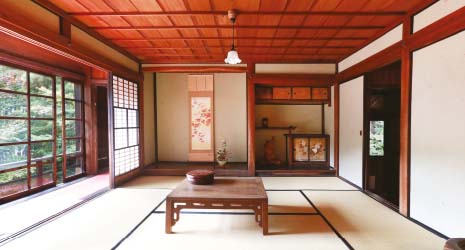Home > Highlighting JAPAN > Highlighting Japan October 2018 > From Meiji to the Present: Looking Back on 150 Years of Progress
Highlighting JAPAN


How Nikko Became a Prime Resort Destination
Foreign diplomats, merchants and missionaries who visited during the early Meiji Period undoubtedly influenced the development of summer resorts in Japan. One such resort, the stylish yet welcoming Kanaya Hotel in Nikko, was the creation of a young court musician. Japan’s oldest Western-style resort hotel, it offers glimpses of a genteel and storied past.
Nikko is a place of singular natural charms that include the Senjogahara Marshland, Lake Chuzenji and Kegon Falls, and offers historic depths in the forms of World Heritage Site Toshogu Shrine and the Shinkyo Bridge. For almost 150 years the Kanaya Hotel, one of the city’s oldest and finest establishments, has provided lodging to travelers from inside and outside Japan who have come to see Nikko’s sights. Kanaya Hotel History House project manager and curator Kiyomi Sakamaki recounts the origins of this venerable hotel.
“In 1870, Zenichiro Kanaya—who was descended from the Kanaya family of Toshogu Shrine court music performers—offered a room in his home to Dr. James C. Hepburn, an American who had come to Nikko to sightsee but could find no place to stay,” Sakamaki says. “Dr. Hepburn told Zenichiro that many more international tourists would be coming to Nikko, and that he should build a hotel for them. That was the origin of Japan’s oldest Western-style resort hotel, the Kanaya Hotel.”
British diplomat Ernest Satow had written about Nikko’s appeal in Yokohama's English-language newspaper the previous year, and Nikko was drawing the attention of foreigners living in Japan. “Zenichiro renovated part of his home, a former Edo Period samurai residence, and in 1873 opened it as the Kanaya Cottage Inn,” Sakamaki notes. “He was just twenty-one then. In an age when even seeing a Westerner was rare, the decision to open a hotel for foreign guests in a location outside Tokyo was quite outside the ordinary.”
According to Sakamaki, the hotel’s reputation in the English-speaking world soared after English travel writer Isabella Bird stayed there in 1878.
“In her travelogue Unbeaten Tracks in Japan, she introduced the rare and uniquely Japanese samurai residence, kept scrupulously clean down to every nook and cranny, the wonderful natural beauty Nikko is blessed with, and the hospitality of Zenichiro’s family, which surpassed any language barriers,” Sakamaki explains. “The book led to a huge upswing in the number of Western guests at the inn.
“In 1893, twenty years after the inn opened, the current Kanaya Hotel was opened in Nikko’s central Kamihatsuishi neighborhood, close to Toshogu Shrine,” Sakamaki continues. “After that, from the end of the Meiji Period (1868-1912) through to the Taisho (1912-26) and Showa (1926-89) periods, many famous and esteemed guests stayed there, including Albert Einstein, Charles Lindbergh and Helen Keller.”
The hotel’s appearance fuses Japanese architectural beauty with Western furniture and fixtures, and retains a distinctly Meiji Period atmosphere that transports guests regardless of origin back in time. In the elegant, European-inspired main dining room, guests can feast on traditional French cuisine made from recipes passed down through generations of head chefs.
In 2003, screenwriter Kundo Koyama began consulting for the hotel, starting new plans such as reviving old recipes long left dormant in the storehouse and creating a suite entitled a “hotel within the hotel.” The resulting media coverage put the hotel in the spotlight and attracted a wide variety of clientele, including couples and families.
The spirit of hospitality that Zenichiro kindled during the early Meiji Period and the place he established to welcome guests from afar have survived unchanged to present-day Nikko.
© 2009 Cabinet Office, Government of Japan







